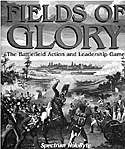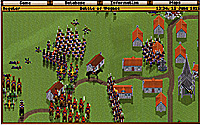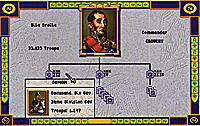 Title: Fields of Glory: The Battlefield Action and Leadership Game
Title: Fields of Glory: The Battlefield Action and Leadership Game
Game Design and Research: Jim Bambra, Adrian Earle
Number of Players: Solitaire only
Playing Time: None noted. You can save a game and come back to it at your leisure.
Complexity Level: Moderate
Packaging: Bookshelf size storage box with full color cover
Map & Playing Pieces: All components exist within the computer (there are some computer games which also include traditional game materials)
Rule Book: 112-page softbound book with foreward by David Chandler, table of contents, glossary, designers' notes, and list of customer support services
Scenarios: Four historical and two fictional
Format Tested: DOS
Media: 3.5" diskettes
System Requirements: IBM 16MHz 80386 w/2MB of RAM, 15 megabytes of hard drive space, a 1.44MB 3.5" floppy drive, mouse, VGA graphics, MS-DOS 5.0 or higher.
Published By: Spectrum Holobyte
Publication Date: 1993
List Price: $45.00
Summary: Fields of Glory (FOG) is a solitaire computer game set during the Waterloo Campaign. It has the virtues of being both visually pleasing and easy to play.
In this sophisticated computer game, the player assumes the role of commanding an army in one of six battles. There is no accommodation for two players. The game is played out on a simulated battlefield, with units positioned in their historical locations (there is an option for players to make their own initial troop dispositions). Several difficulty levels are available for the novice or for the more experienced player.
 On the battlefield map, a large, easy-to-see saber appears on the screen instead of a traditional arrow shaped pointer. Aiming the tip of the saber at a unit and clicking a mouse button accesses a menu of formation choices and deployment options.
On the battlefield map, a large, easy-to-see saber appears on the screen instead of a traditional arrow shaped pointer. Aiming the tip of the saber at a unit and clicking a mouse button accesses a menu of formation choices and deployment options.
The basic combat unit in FOG is the brigade. Orders can be given to the individual brigade, or for an entire Division or corps. Your subordinates at the Division and corps level will carry out your orders while you manage an engagement at another area on the field.
Since the brigade is the smallest game unit, all the troops on the screen are garbed in the uniform of a regiment representative of the entire brigade. In the larger battles where there are more troops involved, there will be at least one brigade wearing your favorite regiment's uniform.
Four historical and two fictional battles are represented. The two fictional battles take place at Nivelles and Wagne, respectively. The historical battles are: Quatre Bras, Ligny, Wavre, and Waterloo. This produces a good mix of French vs. Prussian and French vs. Allies choices. Beginning gamers can cut their teeth on the Nivelles battle, which can be easily played in an hour. The rest of the scenarios would best be played over several sessions.
An additional feature of FOG is a database which contains orders of battle and profiles of notable officers. It is in the database that the regiments making up each brigade are detailed, along with graphics of the uniforms. The database can be accessed while the game is playing.
The game package comes with four diskettes, a manual, a technical supplement, a map poster, and a page of troubleshooting tips. The troubleshooting tips give instructions on how to create a boot disk, which should be used as directed. You also need to have your mouse driver installed in DOS prior to playing FOG. I had some trouble, at first, running FOG because my mouse driver is tied into my Windows environment. Copying my mouse driver program onto the boot disk solved this problem.
Configuration Blues
I found that the installation and start up could have been more user friendly. A beginning computer user may be put off by having to modify system files and creating a boot disk. I found it a minor annoyance to turn on the computer and remember that I'd forgotten to use the boot disk. I wasn't about to change my hard disk's system files to play FOG (the configuration for FOG was not compatible with Windows or my other programs).
FOG is very tactically oriented. Winning and losing appears to be determined by body count. Enemy casualties count for your score and friendly casualties count against your score. There is no consideration for keeping lines of communication open, except that villages count as bonus points at the end of the game.
 FOG's greatest strength is that it looks like a
miniatures wargame, but with animated figures. The graphics at
the more detailed map levels show an impressive amount of detail.
Instead of military map symbols to represent each unit, brigades
are represented by groups of men, horses, or artillery. Each unit
is in proper uniform and equipment. Brigades form up into a good
semblance of a column or line and skirmishing infantry spread out
in the skirmishing line. Artillerymen limber and unlimber their
guns and appear to work around them as puffs of smoke erupt from
the cannon barrels.
FOG's greatest strength is that it looks like a
miniatures wargame, but with animated figures. The graphics at
the more detailed map levels show an impressive amount of detail.
Instead of military map symbols to represent each unit, brigades
are represented by groups of men, horses, or artillery. Each unit
is in proper uniform and equipment. Brigades form up into a good
semblance of a column or line and skirmishing infantry spread out
in the skirmishing line. Artillerymen limber and unlimber their
guns and appear to work around them as puffs of smoke erupt from
the cannon barrels.
The scenery graphics in FOG are superb. The map is decorated with woods, villages, bridges, and streams. After the fighting has commenced, casualties (including horses) permanently litter the field. This unusually detailed feature can be distracting at some of the more contested terrain features. Infantry units occupying buildings as defensive positions is more than symbolic. The massed formation disappears from the screen, to be replaced by the colors raised on the roof and musket muzzles projecting from building windows.
The sound effects are very good. Several song selections play during the initial menu screens. During the game, a number of bugle calls and drum rolls announce your troop deployments. Battlefield sounds, add an audio dimension absent from most serious computer wargames.
Fields of Glory is definitely not a arcade-style video game. The excellent graphics and sound effects, combined with wargame-like formations and orders, make this game a worthwhile purchase.
Back to Empires, Eagles, & Lions Table of Contents #12
Back to Empires, Eagles, & Lions List of Issues
Back to MagWeb Master Magazine List
© Copyright 1995 by The Emperor's Press
This article appears in MagWeb (Magazine Web) on the Internet World Wide Web.
Other military history articles and gaming articles are available at http://www.magweb.com